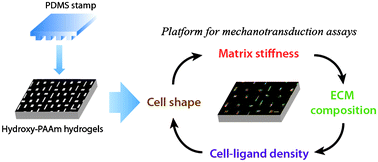A simple route to functionalize polyacrylamide hydrogels for the independent tuning of mechanotransduction cues†
Abstract
Physico-chemical and biochemical factors in the local cellular microenvironment are known to impact on multiple aspects of cell behaviour through specific signal pathways. These mechanotransduction cues can couple each other to regulate cell fate, and it remains unclear whether mechanotransduction in different contexts shares common mechanisms. Undoubtedly, a challenge will involve the further characterization of such cooperative mechanisms, as well as clearly defining the individual role of each mechanical and biochemical parameter. To control these mechanotransduction cues in an independent manner, we developed a simple and efficient strategy to immobilize any desired nature of proteins on polyacrylamide hydrogels and independently control various parameters of the cell microenvironment, such as matrix stiffness, cell-binding ligand density and confined adhesiveness. This novel platform is validated by conducting single-cell experiments and opens a broad avenue for studying complex interplays involved in mechanotransduction with a facile and versatile approach.


 Please wait while we load your content...
Please wait while we load your content...